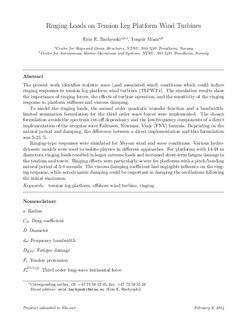| dc.contributor.author | Bachynski, Erin Elizabeth | |
| dc.contributor.author | Moan, Torgeir | |
| dc.date.accessioned | 2018-03-22T12:19:02Z | |
| dc.date.available | 2018-03-22T12:19:02Z | |
| dc.date.created | 2014-08-21T12:51:26Z | |
| dc.date.issued | 2014 | |
| dc.identifier.citation | Ocean Engineering. 2014, 84 237-248. | nb_NO |
| dc.identifier.issn | 0029-8018 | |
| dc.identifier.uri | http://hdl.handle.net/11250/2491700 | |
| dc.description.abstract | The present work identifies realistic wave (and associated wind) conditions which could induce ringing responses in tension leg platform wind turbines (TLPWTs). The simulation results show the importance of ringing forces, the effects of turbine operation, and the sensitivity of the ringing response to platform stiffness and viscous damping. To model the ringing loads, the second order quadratic transfer function and a bandwidth-limited summation formulation for the third order wave forces were implemented. The chosen formulation avoids the spectrum cut-off dependency and the low-frequency components of a direct implementation of the irregular wave Faltinsen, Newman, Vinje (FNV) formula. Depending on the natural period and damping, the difference between a direct implementation and this formulation was 5–25%. Ringing-type responses were simulated for 50-year wind and wave conditions. Various hydrodynamic models were used to isolate physics in different approaches. For platforms with 14–18 m diameters, ringing loads resulted in larger extreme loads and increased short-term fatigue damage in the tendons and tower. Ringing effects were particularly severe for platforms with a pitch/bending natural period of 3–4 s. The viscous damping coefficient had a negligible influence on the ringing response, while aerodynamic damping could be important in damping the oscillations following the initial maximum. | nb_NO |
| dc.language.iso | eng | nb_NO |
| dc.publisher | Elsevier | nb_NO |
| dc.rights | Attribution-NonCommercial-NoDerivatives 4.0 Internasjonal | * |
| dc.rights.uri | http://creativecommons.org/licenses/by-nc-nd/4.0/deed.no | * |
| dc.title | Ringing loads on tension leg platform wind turbines | nb_NO |
| dc.type | Journal article | nb_NO |
| dc.type | Peer reviewed | nb_NO |
| dc.description.version | acceptedVersion | nb_NO |
| dc.source.pagenumber | 237-248 | nb_NO |
| dc.source.volume | 84 | nb_NO |
| dc.source.journal | Ocean Engineering | nb_NO |
| dc.identifier.doi | 10.1016/j.oceaneng.2014.04.007 | |
| dc.identifier.cristin | 1148353 | |
| dc.relation.project | Norges forskningsråd: 223254 | nb_NO |
| dc.description.localcode | © 2014. This is the authors’ accepted and refereed manuscript to the article. This manuscript version is made available under the CC-BY-NC-ND 4.0 license http://creativecommons.org/licenses/by-nc-nd/4.0/ | nb_NO |
| cristin.unitcode | 194,64,20,0 | |
| cristin.unitname | Institutt for marin teknikk | |
| cristin.ispublished | true | |
| cristin.fulltext | postprint | |
| cristin.qualitycode | 1 | |

